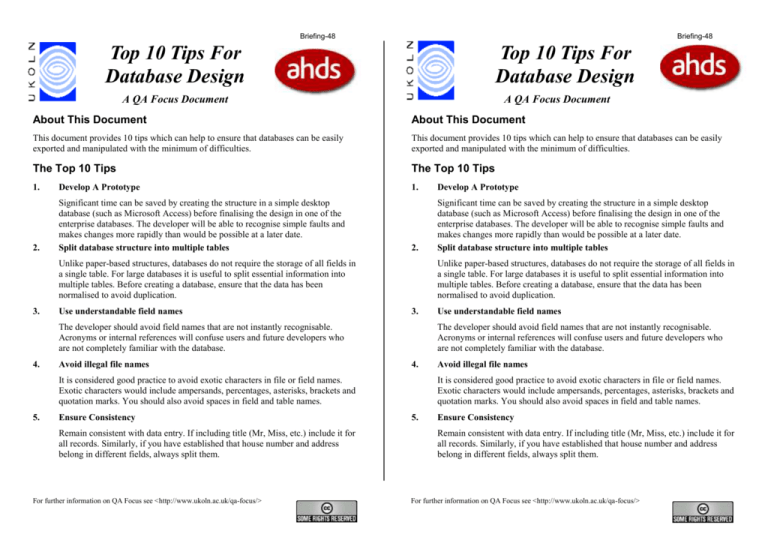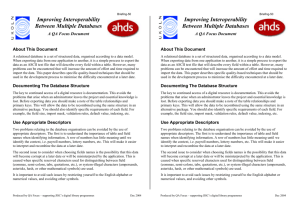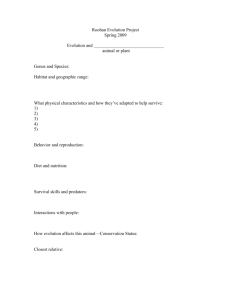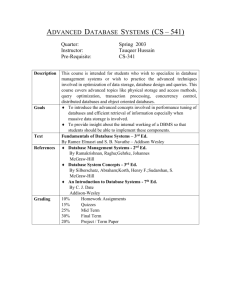Top 10 Tips For Database Design
advertisement

Briefing-48 Briefing-48 Top 10 Tips For Database Design Top 10 Tips For Database Design A QA Focus Document A QA Focus Document About This Document About This Document This document provides 10 tips which can help to ensure that databases can be easily exported and manipulated with the minimum of difficulties. This document provides 10 tips which can help to ensure that databases can be easily exported and manipulated with the minimum of difficulties. The Top 10 Tips The Top 10 Tips 1. Develop A Prototype 1. Develop A Prototype 2. Significant time can be saved by creating the structure in a simple desktop database (such as Microsoft Access) before finalising the design in one of the enterprise databases. The developer will be able to recognise simple faults and makes changes more rapidly than would be possible at a later date. Split database structure into multiple tables 2. Significant time can be saved by creating the structure in a simple desktop database (such as Microsoft Access) before finalising the design in one of the enterprise databases. The developer will be able to recognise simple faults and makes changes more rapidly than would be possible at a later date. Split database structure into multiple tables Unlike paper-based structures, databases do not require the storage of all fields in a single table. For large databases it is useful to split essential information into multiple tables. Before creating a database, ensure that the data has been normalised to avoid duplication. 3. Use understandable field names Unlike paper-based structures, databases do not require the storage of all fields in a single table. For large databases it is useful to split essential information into multiple tables. Before creating a database, ensure that the data has been normalised to avoid duplication. 3. The developer should avoid field names that are not instantly recognisable. Acronyms or internal references will confuse users and future developers who are not completely familiar with the database. 4. Avoid illegal file names The developer should avoid field names that are not instantly recognisable. Acronyms or internal references will confuse users and future developers who are not completely familiar with the database. 4. It is considered good practice to avoid exotic characters in file or field names. Exotic characters would include ampersands, percentages, asterisks, brackets and quotation marks. You should also avoid spaces in field and table names. 5. Ensure Consistency Remain consistent with data entry. If including title (Mr, Miss, etc.) include it for all records. Similarly, if you have established that house number and address belong in different fields, always split them. For further information on QA Focus see <http://www.ukoln.ac.uk/qa-focus/> Use understandable field names Avoid illegal file names It is considered good practice to avoid exotic characters in file or field names. Exotic characters would include ampersands, percentages, asterisks, brackets and quotation marks. You should also avoid spaces in field and table names. 5. Ensure Consistency Remain consistent with data entry. If including title (Mr, Miss, etc.) include it for all records. Similarly, if you have established that house number and address belong in different fields, always split them. For further information on QA Focus see <http://www.ukoln.ac.uk/qa-focus/> Briefing-48 6. Avoid blank fields Briefing-48 6 Avoid blank fields Blank fields can cause problems when interpreting the data at a later date. Does it mean that you have no information, or you have forgotten to enter the information? If information is unavailable it is better to provide a standard response (e.g. unknown). 7. Use standard descriptors for date and time Blank fields can cause problems when interpreting the data at a later date. Does it mean that you have no information, or you have forgotten to enter the information? If information is unavailable it is better to provide a standard response (e.g. unknown). 7 Use standard descriptors for date and time Date and time can be easily confused when exporting database fields in a text file. A date that reads ‘12/04/2003’ can have two meanings, referring to April 12th or December 4th, 2003. To avoid ambiguity always enter and store dates with a four-digit century and times of day using the 24 hour clock. The ISO format (yyyy-mm-dd) is useful for absolute clarity, particularly when mixing databases at a later date. 8. Use currency fields if appropriate Date and time can be easily confused when exporting database fields in a text file. A date that reads ‘12/04/2003’ can have two meanings, referring to April 12th or December 4th, 2003. To avoid ambiguity always enter and store dates with a four-digit century and times of day using the 24 hour clock. The ISO format (yyyy-mm-dd) is useful for absolute clarity, particularly when mixing databases at a later date. 8 Use currency fields if appropriate Currency data types are designed for modern decimal currencies and can cause problems when handling old style currency systems, such as Britain’s currency system prior to 1971 that divided currency into pounds, shillings and pence. 9. Avoid proprietary extensions Currency data types are designed for modern decimal currencies and can cause problems when handling old style currency systems, such as Britain’s currency system prior to 1971 that divided currency into pounds, shillings and pence. 9 Avoid proprietary extensions Care should be taken when using proprietary extensions, as their use will tie your database to a particular software package. Examples of proprietary extensions include the user interface and application-specific commands. 10. Avoid the use of field dividers Care should be taken when using proprietary extensions, as their use will tie your database to a particular software package. Examples of proprietary extensions include the user interface and application-specific commands. 10 Avoid the use of field dividers Commas, quotation marks and semi-colons are all used as methods of separating fields when databases are exported to a plain text file and subsequently reimported into another database. When entering data into a database you should choose an alternative character that represents these characters. Further Information Commas, quotation marks and semi-colons are all used as methods of separating fields when databases are exported to a plain text file and subsequently reimported into another database. When entering data into a database you should choose an alternative character that represents these characters. Further Information SQL Course, <http://www.sqlcourse.com/> SQL Course, <http://www.sqlcourse.com/> A Tutorial on Basic Normalization, Part 1-9, <http://www.datawarehouse.com/article/?articleid=2983> A Tutorial on Basic Normalization, Part 1-9, <http://www.datawarehouse.com/article/?articleid=2983> For further information on QA Focus see <http://www.ukoln.ac.uk/qa-focus/> For further information on QA Focus see <http://www.ukoln.ac.uk/qa-focus/>







